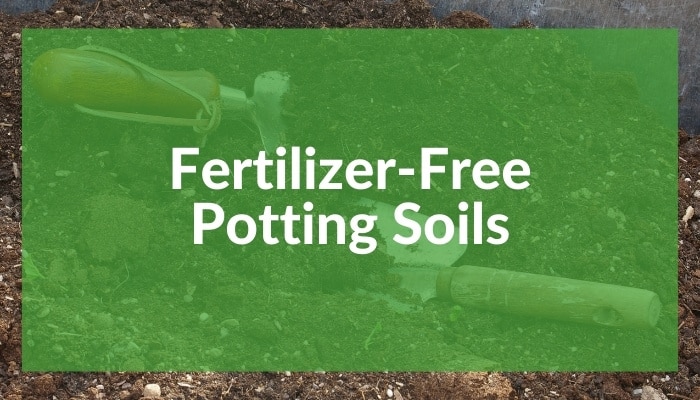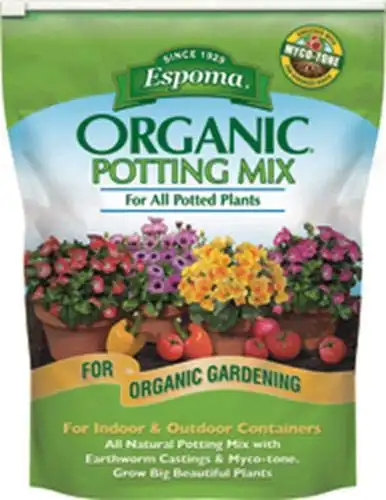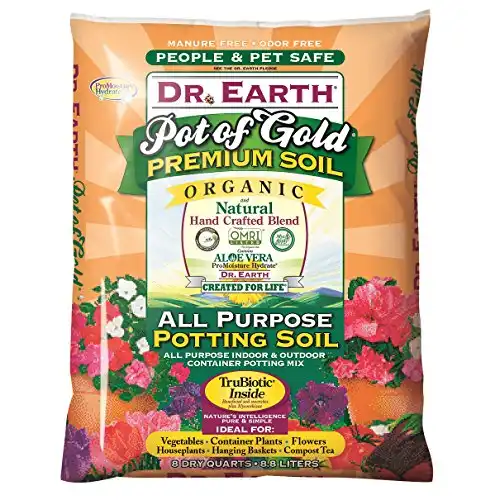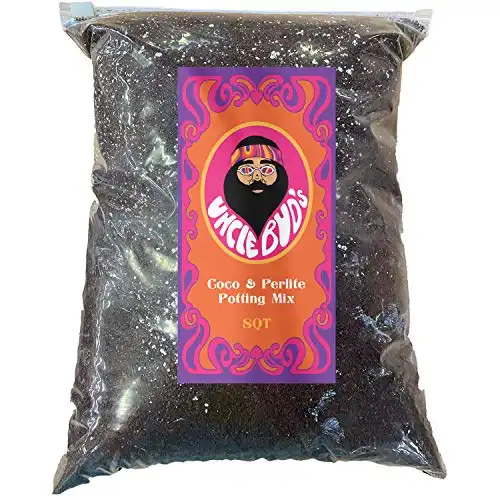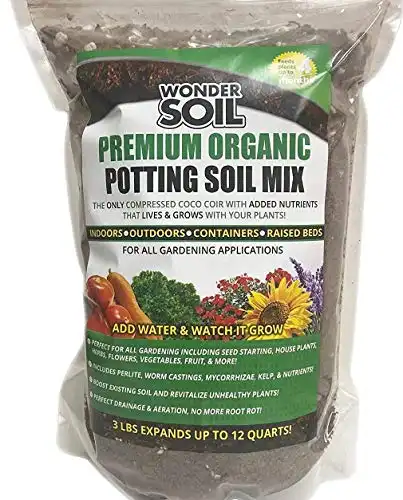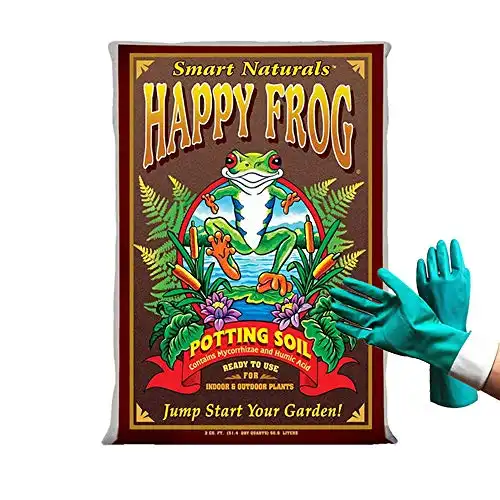To assist casual gardeners, most soil mixes available in the market come with fertilizer. However, this may limit your ability to choose a specific plant feed and could potentially harm the type of plants you are growing.
So what about potting soil without fertilizer?
Certain potting soils are made without fertilizer. This includes organic and soilless blends made from entirely natural ingredients derived from plant and animal waste. Individual products may contain unadvertised booster chemicals and synthetic forms of NPK so ingredient checking is advised.
No-fertilizer potting soil allows you to add a nutrient boost at your discretion, enabling you to put the health of your container garden or houseplant first.
To help you on your way, we’ll look at each soil type in detail, plus our round-up of the best non-fertilizer soils to buy, and more!
Types of Potting Soil That Do Not Contain Fertilizer
There are many potting soil kinds made entirely without fertilizer as listed below. Just be sure to always read the ingredients label of individual products as some may sneak in forms of slow-release fertilizer.
Soilless Mixes
Soilless potting mix resembles soil but is composed of organic materials like crumbled bark, sphagnum (peat moss), perlite (volcanic rock), and coconut fiber and has a light, airy consistency.
This type is chemically inactive, meaning it won’t affect pH levels and has good moisture retention without waterlogging – making it excellent for starting seeds and many moisture-loving houseplants including Ferns, Philodendrons, and Bromeliads.
Organic
This is made with natural matter like compost, manure, and other waste materials and is chemical and pesticide-free.
Organic potting soil increases soil fertility and helps prevent nutrient deficiencies. It’s ideal for growing hungry flowering plants such as Zinnias, Poppies, and Sunflowers as well as vegetable seedlings that are naturally raised in chemical-free cultures such as squash, tomatoes, and zucchini.
Moisture-control Mixes
Moisture-control soil mixes contain micro water beads known as hydrogels which soak up as much moisture as possible. This makes it drier and heavier than most potting soils which work well for drought-tolerant, clay-loving plants like Hydrangeas, Lilacs, and Roses.
Some gardeners find this moisture-retaining innovation beneficial for the growth of outdoor container plants in Grow zones 8 and above since they remain moist throughout hot summers. Indoor plants, however, are more susceptible to rot when grown in this mix.
Coco Coir Blends
These mixes are made with shredded coconut husks known as ‘coir’ in Southeast Asia in addition to peat moss and worm castings to deliver a well-draining, moisture-retaining medium.
The coir element makes an enriching topsoil amendment in outdoor gardening and a fertile soil mix for seed sprouting and newly propagated seedlings. Its nutrient-rich matter also benefits Ferns, Anthuriums, and Orchids.
Orchid Mixes
This soilless potting mix mimics the chunky medium Orchids grow in naturally and contains materials such as lava rock, coco coir, fir bark, cork nuggets, and charcoal.
Its loose, bulky texture and superb drainage quality make Orchid mixes an attractive topdressing for houseplants and a good pest deterrent as they’re more inclined to nest in denser soils. Plants with similar growing needs benefit from this mix such as Hoyas, Pothos, and Philodendrons.
Difference Between Organic and Synthetic Fertilizers
Organic fertilizers are made using plant or animal waste such as aged manure and leaf mold, whereas synthetic fertilizers contain petroleum products and the synthesized chemicals of Nitrogen, Phosphorus, and Potassium
Organic
Pros:
- Slow-release of nutrients
- Improves soil structure and fertility
- No toxic build-up
- Retains water better
Cons:
- Takes time to break down
- Tricky to apply precisely
Synthetic
Pros:
- Fast-acting for remedying nutrient deficiencies
- Easier, more even application
- Inexpensive
Cons:
- Overuse can cause plant burn
- Rapid release can leave nutrients deep in soil and inaccessible to plants
While the US Department of Agriculture doesn’t regulate the labeling of potting soils, look for products with ‘OMRI’, ‘CDFA’, or ‘WSDA’ logos, as these organizations produce certifiably organic, synthetic-free fertilizers.
List of No-Fertilizer Potting Soils
Checking the ingredients label on in-store products or mixing your own soil is the best way to avoid fertilizer. In the meantime, here are our top picks for no-fertilizer potting soils:
Espoma Organic Potting Mix
This is an all-natural blend for indoor and outdoor container plants containing a water-saving Myco-tone formula that promotes root growth, increases absorbency, and reduces transplant shock.
Ingredients:
- 11 strains of beneficial Mycorrhizal fungi
- 45-55% peat moss
- Perlite
- Peat humus
- Dolomitic limestone
Dr. Earth Pot of Gold Organic Soil
An all-purpose, OMRI-listed natural mix for indoor and outdoor potted and container plants, flowers, herbs, and veg. Its organic formula makes it ideal soil amendment, compost, seed cover, and mulch.
Ingredients:
- ‘TruBiotic’ soil microbes
- Aged fir bark
- Composted green waste
- Wild-caught fish bonemeal
- Sawdust
- Kelp flour
Uncle Bud’s Coco and Perlite Mix
This pH-balanced coco coir blend has been double-washed to remove contaminants and can be used directly with no additional ingredients. Excellent aeration helps prevent overwatering issues in outdoor/indoor container gardens.
Ingredients:
- 50/50 Coco Coir peat and Perlite (volcanic rock)
Wonder Soil
An OMRI-certified mix made with compressed coco coir and additional organic matter for indoor and outdoor container pots and raised beds. It can also be used to reinvigorate existing container/ground soil.
Ingredients:
- Perlite
- Kelp
- Worm castings
- Mycorrhizae
- Humus
- Magnesium
Happy Frog Potting Soil
This organic soil is made with indoor/outdoor container gardens in mind. Beneficial soil microbes promote nutrient intake and boost root efficiency to enhance fruit and flower production and strengthen plant structures.
Ingredients:
- Mycorrhizal fungi
- Humic acid
- Worm castings
- Bat guano
Related Questions:
Are Potting Soil and Potting Mix the Same?
Potting soil consists of minerals, compost, and garden soil, whereas potting mix does not contain soil at all. Potting mix is sterile as it doesn’t contain microorganisms as a result of broken-down organic matter. Potting mix has a lighter structure, consisting of things like perlite, bark, and coir.
Can I Use Bagged Garden Soil for Indoor Plants?
It is not recommended since garden soil has a heavy, compacted structure. When used alone in indoor or outdoor plant containers, the compressed nature of garden soil can suffocate the roots and increase the risk of rot due to clogged waterlogged soil.
Conclusion
In summary, no-fertilizer potting soil exists and carries many benefits – just be sure to carefully read the ingredients label on big brand soil mixes claiming to be ‘natural’ as these may contain synthetic forms of NPK to give plants a hidden boost.
Don’t forget that any form of fertilizer will be exhausted in potting soil after a while, so you may decide it’s easier to add homemade fertilizer to your own potting soil mixture.

